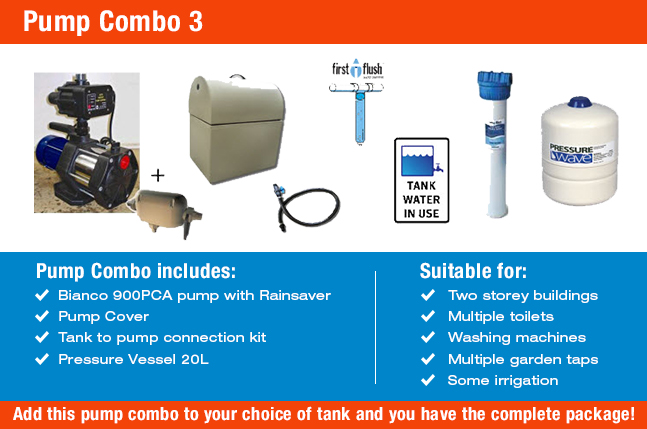The size of your Tank and pump is an important factor to take into consideration when choosing a water harvesting system. Why? Because size determines the affordability, durability and efficiency of a water harvesting system. Individuals residing in single storey buildings with adequate plumbing require pumps which are able to deliver water at a pressure of 35.40 PSI. Residences more than one storey high require an increase in pumping pressure.

Bianco 900PCA pump with Rainsaver Combo
Obviously, choosing the size of your tank depends firstly on how much space you have to locate the tank as close as possible to your harvested water source, whether that is rainwater, bore water, spring, lake or river water. If, as in this case, we are talking about rainwater, the size of your roof and annual rainfall in your locality will determine how much rain can be harvested and stored economically. There are several good online rainwater catchment tools and one of them, the Rainfall and Roof Catchment Calculator, can be found on our website, Rainwater Tanks Direct, in the “How to Order” Drop Down Menu. In most areas of Australia there are a number of tank manufacturers, water tank resellers, both online like Rainwater Tanks Direct and retail, such as Bunnings, and also installers so that the Australian consumer looking for a water tank has plenty of choice. Different manufacturers of water tanks used for water harvesting systems such as those listed in Rainwater Tanks Direct mean that consumers can have access to a veritable supermarket of tank sizes and styles by just clicking on a reseller’s website. Rainwater Tanks Direct is based in Sydney with more than 4 years’ experience in the industry. The water tanks Rainwater Tanks Direct sells are manufactured with exceptional quality and can be for rural, domestic, commercial or even industrial use. Choosing the right size tank for both your location and your requirements is the first step in creating an efficient water harvesting system. The next consideration is the size of the pump needed to get your harvested rainwater to where it is needed: the garden, toilets, laundry and so on. It is important to remember that with pumps, bigger is not necessarily better. Bigger and more powerful pumps will certainly get the water to your lawn faster, but may consume more energy than necessary so that you end up spending more money on your power bill than you are saving on your water bill. Do your research first and speak to your plumber or experienced quality pump retailer to find out what size of pump you require. Don’t forget to include all the information they will need in order to help you make the right choice for pump for your needs. There is no need to spend thousands of dollars if all you need to do is to water a small urban garden. On the other hand if you live in a large two or three storey house with several toilets and are on town water, make sure you purchase a pump which is powerful enough to handle the demand and which comes with automatic switching (RainBank™, RainSaver™ or RainChangeover™) between mains water and the water in your rainwater tank. Consider also factors such as the pump warranty, ease of obtaining spare parts and service and ease of maintenance. Unless you choose a submersible pump, the durability of most pumps connected to a rainwater tank will be extended by the purchase of a pump cover to protect the pump from accidental damage and dust.



Leave A Comment